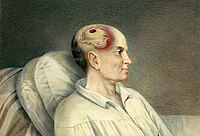
Photo from wikipedia
INTRODUCTION Homotopic functional connectivity (HoFC), the synchrony in activity patterns between homologous brain regions, is a fundamental characteristic of resting-state functional connectivity (RsFC). METHODS We examined the difference in HoFC,… Click to show full abstract
INTRODUCTION Homotopic functional connectivity (HoFC), the synchrony in activity patterns between homologous brain regions, is a fundamental characteristic of resting-state functional connectivity (RsFC). METHODS We examined the difference in HoFC, computed as the correlation between atlas-based regions and their counterpart on the opposite hemisphere, in 16 moderate-severe traumatic brain injury patients (msTBI) and 36 healthy controls. Regions of decreased HoFC in msTBI patients were further used as seeds for examining differences between groups in correlations with other brain regions. Finally, we computed logistic regression models of regional HoFC and fractional anisotropy (FA) of the corpus callosum (CC). RESULTS TBI patients exhibited decreased HoFC in the middle and posterior cingulate cortex, thalamus, superior temporal pole, and cerebellum III. Furthermore, decreased RsFC was found between left cerebellum III and right parahippocampal cortex and vermis, between superior temporal pole and left caudate and medial left and right frontal orbital gyri. Thalamic HoFC and FA of the CC discriminate patients as msTBI with a high accuracy of 96%. CONCLUSION TBI is associated with regionally decreased HoFC. Moreover, a multimodality model of interhemispheric connectivity allowed for a high degree of accuracy in disease discrimination and enabled a deeper understanding of TBI effects on brain interhemispheric reorganization post-TBI.
Journal Title: Cerebral cortex
Year Published: 2022
Link to full text (if available)
Share on Social Media: Sign Up to like & get
recommendations!